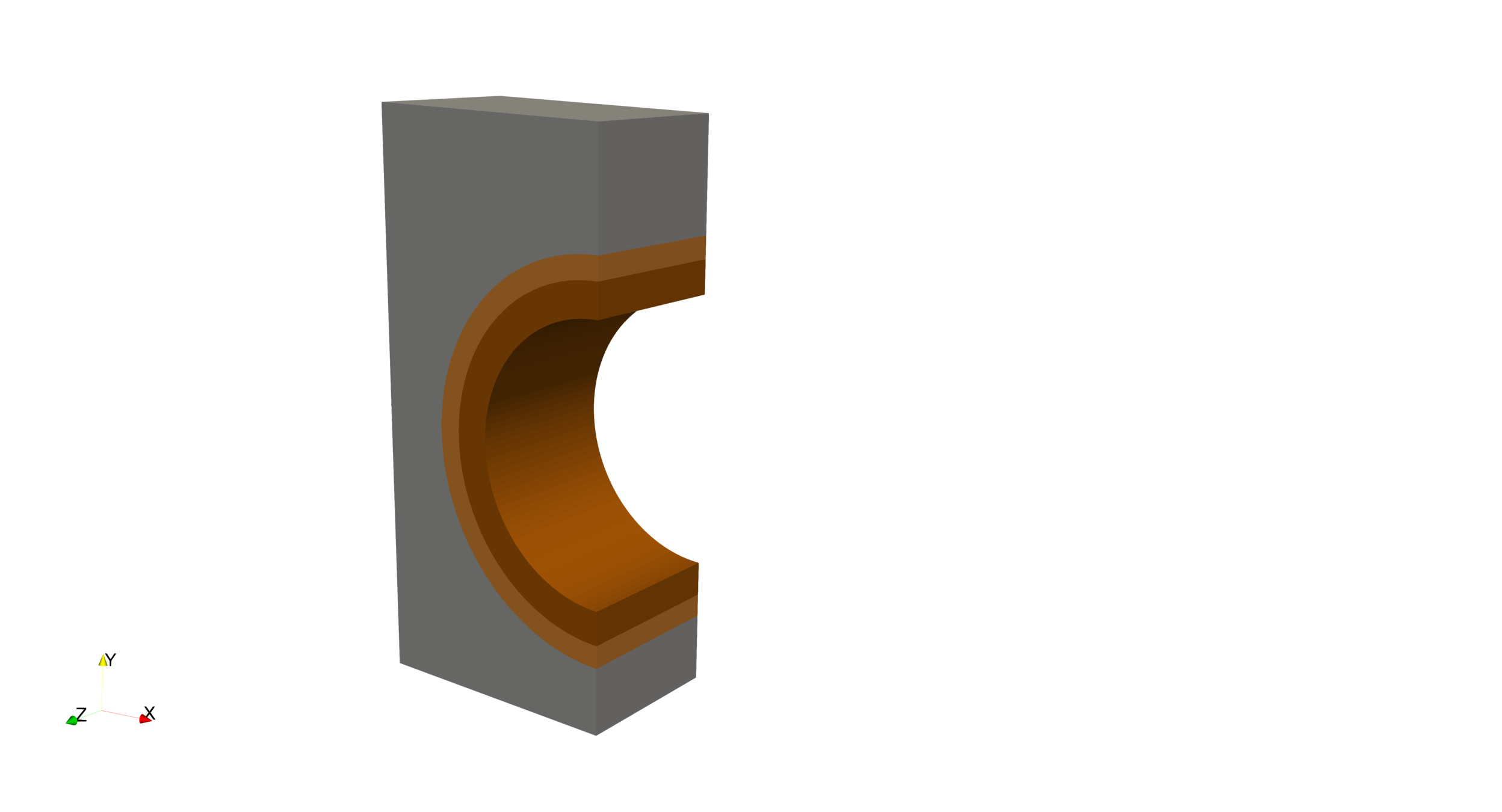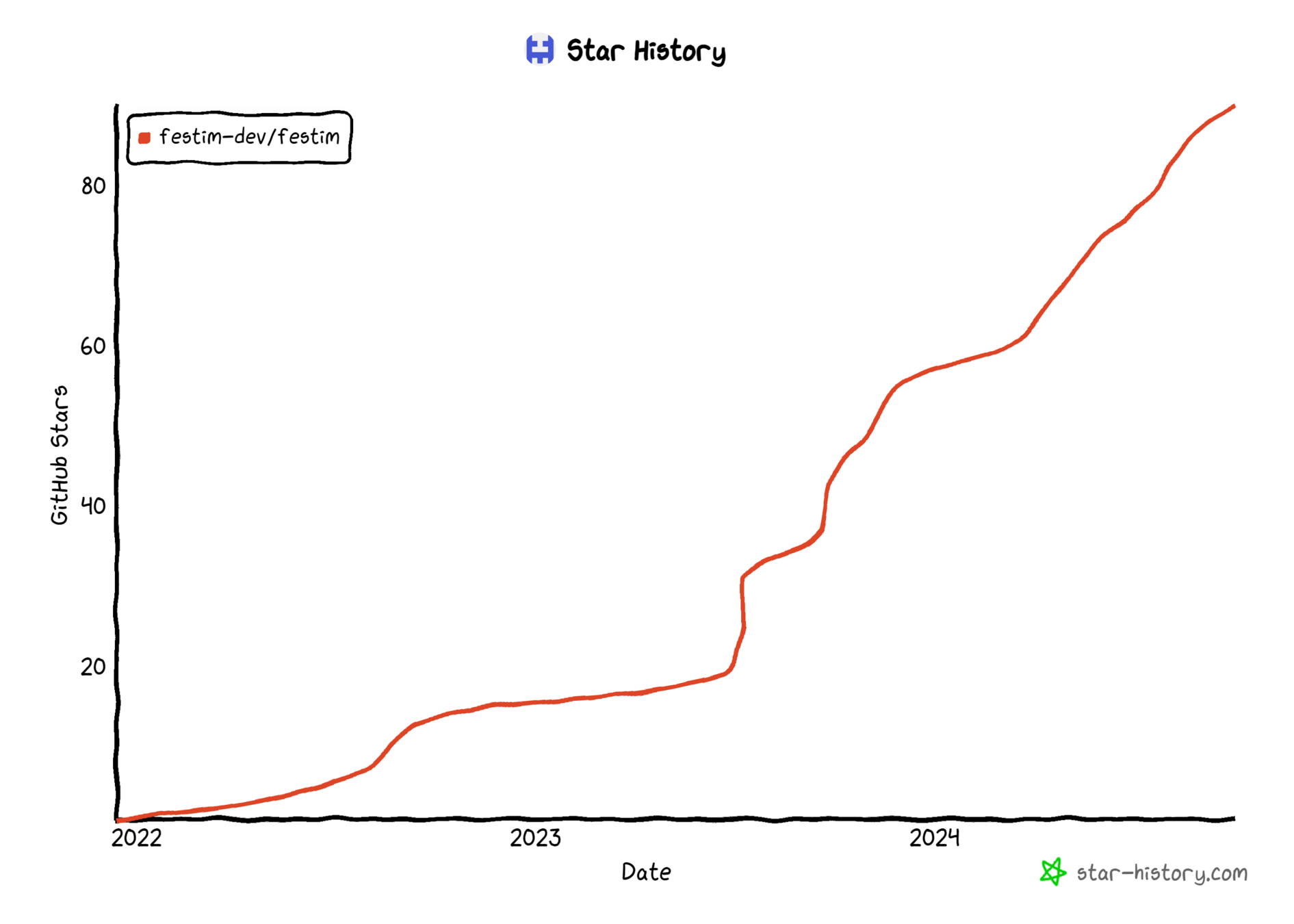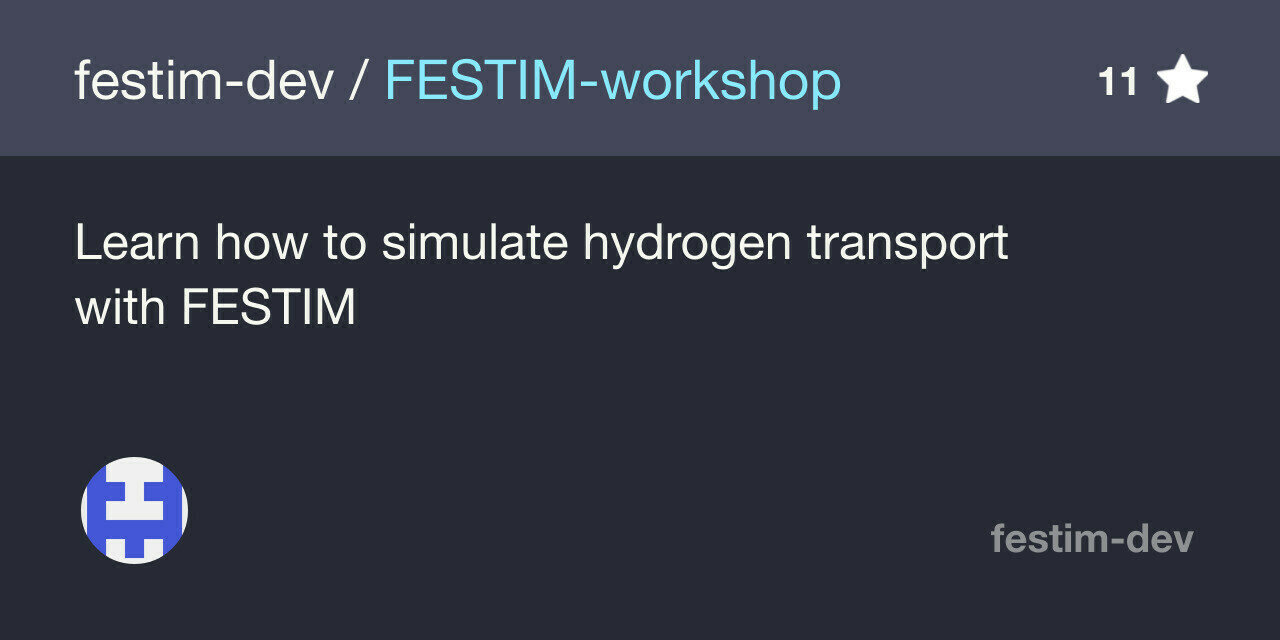FESTIM: status and developments after 5 years of hydrogen transport modelling
Remi Delaporte-Mathurin


User inputs
- Material properties
- Trap properties
- Geometry
- Boundary conditions
- Initial conditions
- ...
Heat transfer model
Hydrogen transport model
- McNabb & Foster
- Multi-level trapping
- Multi-isotopes
- ...
FESTIM
Outputs
- H concentration fields \(c(x,t)\)
- Temperature field \(T(x,t)\)
- surface fluxes
- inventories
- average concentration
- ...

2019
Start of development
We need a new tool!
Problem: predict T retention and permeation
- Multi-dimensional
- Multi-material
- non homogeneous temperature
W
Cu
CuCrZr
Particle and heat fluxes


Convection
14 mm

2022
License Apache 2.0

✅ More transparency
- Reproducibility in papers
- Source code available
✅ More collaborations
- No need for complex collaboration agreements
- External contributions
✅ More flexibility
- Can be adapted to your needs
- Better interoperability
2019
Open source
We need a numerical tool
Problem: predict T retention and permeation
- Multi-dimensional
- Multi-material
- non homogeneous temperature
W
Cu
CuCrZr
Particle and heat fluxes


Convection
14 mm
2022
License Apache 2.0

✅ More transparency
- Reproducibility in papers
- Source code available
✅ More collaborations
- No need for complex collaboration agreements
- External contributions
✅ More flexibility
- Can be adapted to your needs
- Better interoperability
Oct 2023
v1.0 release
2019
v1.0 release
We need a numerical tool
Problem: predict T retention and permeation
- Multi-dimensional
- Multi-material
- non homogeneous temperature
W
Cu
CuCrZr
Particle and heat fluxes


Convection
14 mm
2022
Oct 2023
April 2024

Non-profit organisation supporting open source software for science and research
More info at numfocus.org
2019
We need a numerical tool
Problem: predict T retention and permeation
- Multi-dimensional
- Multi-material
- non homogeneous temperature
W
Cu
CuCrZr
Particle and heat fluxes


Convection
14 mm
2022
Oct 2023

April 2024
Non-profit organisation supporting open source software for science and research
More info at numfocus.org
Meet the development team
Jonathan Dufour
CEA, France
+ many other contributors







fork
fork
pull request
FESTIM
Jane
FESTIM
John
FESTIM
festim-dev
pull request
✅
❌
FESTIM is open-source
The code is missing a feature?
Just add it!
Found a bug?
Report it and we'll fix it!
How to use FESTIM


Documentation
and installation instructions
FESTIM is user-friendly

- Very easy to learn
- Plenty of libraries (numpy, scipy, matplotlib, HTM...)
- Inuitive interface
conda install -c conda-forge fenics
pip install festimTwo lines to install!
import festim as F
import numpy as np
my_model = F.Simulation()
my_model.mesh = F.MeshFromVertices(
vertices=np.linspace(0, 1e-6, num=1001)
)
my_model.materials = F.Material(id=1, D_0=1.9e-7, E_D=0.2)
my_model.T = 500 # K
my_model.boundary_conditions = [
F.DirichletBC(
surfaces=[1, 2],
value=1e15, # H/m3/s
field=0
)
]
my_model.settings = F.Settings(
absolute_tolerance=1e10,
relative_tolerance=1e-10,
final_time=100 # s
)
my_model.dt = F.Stepsize(0.1) # s
my_model.initialise()
my_model.run()
FESTIM is user-friendly
- Online user support forum
- Anyone from the community can answer questions (developers and users)
The FESTIM-workshop offers dozens of tutorials
Available at:
github.com/festim-dev/FESTIM-workshop
FESTIM is user-friendly


Runs in your browser without installing anything!

UKAEA Aug 2024
FESTIM is user-friendly

To date, 4 user workshops have been organised, covering:
- Basic usage
- Advanced usage
- Hackathons
- How to contribute
UKAEA Aug 2024
~60 attendees in total!
FESTIM is fully documented
Installation instructions
User guide
FESTIM is verified & validated
-
Validated against TDS, permeation experiments...
-
Verified against analytical solutions in many different problems
- New V&V online book
festim-vv-report.readthedocs.io
14 verification cases (4 in progress)
6 validation cases (5 in progress)
Method of Exact Solution
governing equations
exact solutions
parameters (sources, BCs, ICs)
FESTIM
computed solutions
solve
run
compare
⚠️sometimes very complex!
Method of Manufactured Solutions
governing equations
manufactured solutions
source terms, BCs and ICs
FESTIM
computed solutions
compare

V&V
Effective-diffusion through a slab

2D multi-material
Exact
Computed concentration
FESTIM is verified & validated
Transparent
- all the code is available
- including pre- and post-processing
Reproducible
- Nothing is hard coded
- All cases are run automatically
Version control
- Source code of the book available on GitHub
- Contributions are welcome!
FESTIM is used worldwide

8 private companies
13 universities
18 research organisations



📈5 years of development
📑14+ publications
🗣️110+ citations
🧑💻20+ contributors
🏛️26+ institutions using the code
🧑💻70+ Slack members
⭐90+ stars on GitHub
🧑💻4 workshops
FESTIM in numbers

Evolution of GitHub stars
Open source
SOFE
New reference paper
Kyoto Fusioneering
UKAEA
IPP
Retention studies

- Delaporte-Mathurin et al 2024 International Journal of Hydrogen Energy 63 786–802
- Delaporte-Mathurin et al 2024 Nucl. Fusion 64 026003

- ITER plasma facing components
- Transient estimation of tritium retention
Detritiation studies


Influence of ELMs on retention

- 1D model of a ITER monoblock
- Transient heat transfer simulation
- Varying surface heat flux
Permeation experiment

No barrier
with barrier
Permeation barrier
Substrate
High H pressure
Low H pressure
Permeation flux
TDS analysis




Breeding Blanket modelling



- DEMO WCLL
- Complex 3D geometry
- Coupled to fluid dynamics
- Tritium generation in the LiPb volume (computed from OpenMC)
James Dark et al 2021 Nucl. Fusion 61 116076
Tritium extraction system

K. Dunnell (MIT)
- Permeation Against Vacuum
- Complex 3D geometry
- Coupled with fluid dynamics
- Tritium extraction from permeable membranes

BABY tritium breeding experiment

Velocity
Temperature
Tritium concentration
C. Weaver (MIT)

① neutrons are generated
② tritium is created from nuclear reactions
③ tritium is transported in the salt
④ tritium is released into the gas phase
⑤ tritium is collected and counted
BABY breeding experiment
Kinetic surface model

Paper is progress...




New in v1.3!
V&V available at
github.com/KulaginVladimir/FESTIM-SurfaceKinetics-Validation

FESTIM can inform fuel cycle models
Text
Metal Foil Pumps for DIR

- H is implanted in the first \( 10 \ \mathrm{nm} \)
- Super-permeation regime is attained at high recombination energy (upstream surface)
- Source code

Benedikt & Day, (2017) Fusion Engineering and Design
I want multi-isotopes😠
tRaPs aT iNtErFaCeS! 🫠
I only trust multi-level occupancy trapping 🥴
What about the diffusion of intersitials?! 🤔
Traps can diffuse! 😠
2022
2019
Start of development
open source
2023
v1.0 release
2024

Towards FESTIM 2
FESTIM limitations
Parallel scaling issues
Technical debt
Legacy FEniCS deprecated
Current interface condition does not scale well
Many hard coded foundations
Implementation of new features is more complex
Bugs not being fixed
Can't take advantage of new features
FEniCSx




New Features
Multi-isotope transport
New mesh types
Validation on PFCs
Chemical reactions
External physics integration
Anisotropic diffusion







Multilevel trapping
Massively parallel
Towards the future: FESTIM 2
Chemical reactions
- More suitable for molten salts
- Even more flexibility
Multi-species transport
- Isotopic exchange
- Multi-level trapping
- Transport of impurities, He, interstitials...
- Validation on WEST PFCs
Finite element engine upgrade
- Better performances (including in parallel)
- Bigger models
- Mixed topology meshes
Graphical user interface?
New examples
Spherical cavity trapping

see Zibrov and Schmid, NME, 2024
for complete description
- Implementation in FESTIM of the spherical cavity trapping model developed by Zibrov and Schmid
- Custom trapping equations
- Smooth implementation in FESTIM

Interface discontinuity
- 2 materials
- 1 mobile + 1 trap
Pull request under review #878
But this changes a lot of things!
FESTIM 1
with dolfinx
1 mesh for the whole domain
1 mesh for the whole domain
Submesh 1
Submesh 2
VectorFunctionSpace \(V\) (eg. 3 components)
Function \(u\) (eg. 3 components)
VectorFunctionSpace \(V_1\)
\(V_2\)
Function \(u_1\) (eg. 2 comps.)
\(u_2\) (eg. 3 comps.)
1 function for the whole domain
1 function per subdomain
Isotope swapping


same underlying equations!
Can be represented by festim.Reaction
Isotope swapping
my_model.species = [
mobile_H,
mobile_D,
trapped_H,
trapped_D,
]
my_model.reactions = [
F.Reaction(
k_0=k_0,
E_k=0.39,
p_0=1e13,
E_p=1.2,
reactant1=mobile_H,
reactant2=empty_trap,
product=trapped_H,
volume=my_subdomain,
),
F.Reaction(
k_0=k_0,
E_k=0.39,
p_0=1e13,
E_p=1.2,
reactant1=mobile_D,
reactant2=empty_trap,
product=trapped_D,
volume=my_subdomain,
),
F.Reaction(
k_0=k_0,
E_k=0.1,
p_0=k_0,
E_p=0.1,
reactant1=mobile_H,
reactant2=trapped_D,
product=[mobile_D, trapped_H],
volume=my_subdomain,
),
]Usual trapping reactions
Swapping reaction
4 species are defined
Multi-isotope, multi-level trapping

- 7 different species
- 6 reactions
- \( c_H = 10^{20} \ \mathrm{m^{-3}} \) on the left
- \( c_D = 10^{19} \ \mathrm{m^{-3}} \) on the right
- Source code available here
1 trap, 2 levels, 2 isotopes
\( \mathrm{H} \) = mobile H
\( \mathrm{D} \) = mobile D
\( [\mathrm{H}_x\mathrm{D}_y] \) = \(x\) H and \(y\) D in trap
Anisotropy
- Anisotropic materials can be simulated with very few modifications
- Composites
- Anisotropic microstructures



Follow the development roadmap

When is FESTIM 2 released?
Anonymous FESTIM dev
We don't know. But it'll be sooner if you help us!
Anonymous FESTIM user
Open-source is win-win
🚀FESTIM benefits from the community
- New use cases
- New features
- Improved documentation
- V&V
🚀The community benefits from FESTIM
- 21+ active projects using FESTIM
- ~30 institutions using the code
- 4 workshops
What FESTIM needs to thrive?
More external contributions!
💵Funding: no project currently supports FESTIM dev
🧑💻Code: only 3 core developers (only one permanent)


